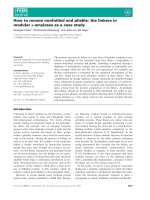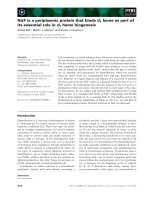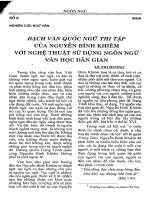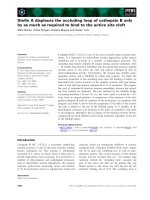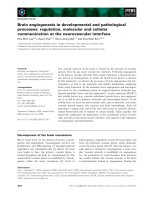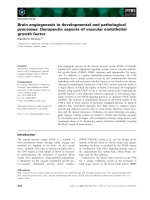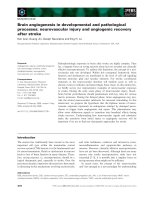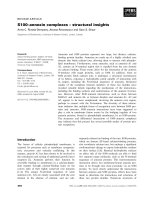Tài liệu Báo cáo khoa học: "Discourse Relations: A Structural and Presuppositional Account Using Lexicalised TAG*" docx
Bạn đang xem bản rút gọn của tài liệu. Xem và tải ngay bản đầy đủ của tài liệu tại đây (693.15 KB, 8 trang )
Discourse Relations: A Structural and Presuppositional Account Using
Lexicalised TAG*
Bonnie Webber
Univ of Edinburgh
Alistair Knott
Univ of Otago
Matthew Stone
Rutgers Univ
Aravind Joshi
Univ of Pennsylvania
joshi @cis.upenn.edu
Abstract
We show that discourse structure need not bear
the full burden of conveying discourse relations by
showing that many of them can be explained non-
structurally in terms of the grounding of anaphoric
presuppositions (Van der Sandt, 1992). This simpli-
fies discourse structure, while still allowing the real-
isation of a full range of discourse relations. This is
achieved using the same semantic machinery used
in deriving clause-level semantics.
1 Introduction
Research on discourse structure has, by and large,
attempted to associate all meaningful relations
between propositions with structural connections
between discourse clauses (syntactic clauses or
structures composed of them). Recognising that this
could mean multiple structural connections between
clauses, Rhetorical Structure Theory (Mann and
Thompson, 1988) simply stipulates that only a
single relation may hold. Moore and Pollack (1992)
argue that both informational (semantic) and inten-
tional relations can hold between clauses simultan-
eously and independently. This suggests that factor-
ing the two kinds of relations might lead to a pair
of structures, each still with no more than a single
structural connection between any two clauses.
But examples of multiple semantic relations are
easy to find (Webber et al., 1999). Having struc-
ture account for all of them leads to the complex-
ities shown in Figure 1, including the crossing de-
pendencies shown in Fig. l c. These structures are
no longer trees, making it difficult to define a com-
positional semantics.
This problem would not arise if one recognised
additional, non-structural means of conveying se-
mantic relations between propositions and modal
* Our thanks to Mark Steedman, Katja Markert, Gann Bierner
and three ACL'99 reviewers for all their useful comments.
operators on propositions. This is what we do here:
Structurally, we assume a "bare bones" dis-
course structure built up from more complex
elements (LTAG trees) than those used in many
other approaches. These structures and the op-
erations used in assembling them are the basis
for compositional semantics.
Stimulated by structural operations, inference
based on world knowledge, usage conventions,
etc., can then make defeasible contributions to
discourse interpretation that elaborate the non-
defeasible propositions contributed by com-
positional semantics.
Non-structurally, we take additional semantic
relations and modal operators to be conveyed
through anaphoric presuppositions (Van der
Sandt, 1992) licensed by information that
speaker and hearer are taken to share. A main
source of shared knowledge is the interpreta-
tion of the on-going discourse. Because the
entity that licences (or "discharges") a given
presupposition usually has a source within the
discourse, the presupposition seems to link the
clause containing the presupposition-bearing
(p-bearing) element to that source. However,
as with pronominal and definite NP anaphora,
while attentional constraints on their interpret-
ation may be influenced by structure, the links
themselves are not structural.
The idea of combining compositional semantics
with defeasible inference is not new. Neither is the
idea of taking certain lexical items as anaphorically
presupposing an eventuality or a set of eventualities:
It is implicit in all work on the anaphoric nature of
tense (cf. Partee (1984), Webber (1988), inter alia)
and modality (Stone, 1999). What is new is the way
we enable anaphoric presupposition to contribute to
semantic relations and modal operators, in a way
41
Ci Ci
(a)
R1 R 2
C I Ci C k Ci C i C k C m
(b) (c)
Figure 1: Multiple semantic links
(R j)
between
discourse clauses
(Ci):
(a) back to the same discourse clause;
(b) back to different discourse clauses; (c) back to different discourse clauses, with crossing dependencies.
that does not lead to the violations of tree structure
mentioned earlier.t
We discuss these differences in more detail in
Section 2, after describing the lexicalised frame-
work that facilitates the derivation of discourse se-
mantics from structure, inference and anaphoric
presuppositions. Sections 3 and 4 then present more
detailed semantic analyses of the
connectives for ex-
ample
and
otherwise.
Finally, in Section 5, we sum-
marize our arguments for the approach and suggest
a program of future work.
2
Framework
In previous papers (Cristea and Webber, 1997;
Webber and Joshi, 1998; Webber et al., 1999), we
have argued for using the more complex structures
(elementary trees) of a Lexicalized Tree-Adjoining
Grammar (LTAG) and its operations (adjoining and
substitution) to associate structure and semantics
with a sequence of discourse clauses. 2 Here we
briefly review how it works.
In a lexicalized TAG, each elementary tree has at
least one anchor. In the case of discourse, the an-
chor for an elementary tree may be a lexical item,
punctuation or a feature structure that is lexically
null. The semantic contribution of a lexical anchor
includes both what it presupposes and what it as-
serts (Stone and Doran, 1997; Stone, 1998; Stone
and Webber, 1998). A feature structure anchor will
either unify with a lexical item with compatible fea-
tures (Knott and Mellish, 1996), yielding the previ-
ous case, or have an empty realisation, though one
1One may still need to admit structures having both a link
back and a link forward to different clauses (Gardent, 1997).
But a similar situation can occur within the clause, with rel-
ative clause dependencies - from the verb back to the relative
pronoun and forward to a trace - so the possibility is not unmo-
tivated from the perspective of syntax.
2We take this to be only the most basic level of discourse
structure, producing what are essentially extended descriptions
of situations/events. Discourse may be further structured with
respect to speaker intentions, genre-specific presentations, etc.
that maintains its semantic features.
The initial
elementary trees used here corres-
pond, by and large, to second-order predicate-
argument structures - i.e., usually binary predicates
on propositions or eventualities - while the
auxil-
iary
elementary trees provide further information
(constraints) added through adjoining.
Importantly, we
bar
crossing structural connec-
tions. Thus one diagnostic for taking a predicate
argument to be
anaphoric
rather than
structural
is
whether it can derive from across a structural link.
The relation in a subordinate clause is clearly struc-
tural: Given two relations, one realisable as "Al-
though o¢ [3, the other realisable as "Because y ~5",
they cannot together be realised as "Although ~ be-
cause y [3 &" with the same meaning as "Although
o¢ [3. Because y 8". The same is true of certain re-
lations whose realisation spans multiple sentences,
such as ones realisable as "On the one hand oz. On
the other hand 13." and "Not only T- But also &" To-
gether, they cannot be realised as "On the one hand
o¢. Not only T. On the other hand 13. But also &"
with the same meaning as in strict sequence. Thus
we take such constructions to be structural as well
(Webber and Joshi, 1998; Webber et al., 1999).
On the other hand, the
p-bearing
adverb "then",
which asserts that one eventuality starts after the
culmination of another, has only one of its argu-
ments coming structurally. The other argument is
presupposed and thus able to come from across a
structural boundary, as in
(1) a. On the one hand, John loves Barolo.
b. So he ordered three cases of the '97.
c. On the other hand, because he's broke,
d. he
then
had to cancel the order.
Here, "then" asserts that the "cancelling" event in
(d) follows the ordering event in (b). Because the
link to (b) crosses the structural link in the parallel
construction, we take this argument to come
non-
42
structurally through anaphoric presupposition. 3
Now we illustrate briefly how short discourses
built from LTAG constituents get their semantics.
For more detail, see (Webber and Joshi, 1998;
Webber et al., 1999). For more information on com-
positional semantic operations on LTAG derivation
trees, see (Joshi and Vijay-Shanker, 1999).
(2) a. You shouldn't trust John because he never
returns what he borrows.
b. You shouldn't trust John. He never returns
what he borrows.
C. You shouldn't trust John because, for ex-
ample, he never returns what he borrows.
d. You shouldn't trust John. For example, he
never retums what he borrows.
Here A will stand for the LTAG parse tree for "you
shouldn't trust John" and a, its derivation tree, and
B will stand for the LTAG parse tree for "he never
returns what he borrows" and 13, its derivation tree.
The explanation of Example 2a is primarily struc-
tural. It involves an initial tree (y) anchored by "be-
cause" (Figure 2). Its derived tree comes from A
substituting at the left-hand substitution site of y (in-
dex 1) and B at the right-hand substitution site (in-
dex 3). Semantically, the anchor of y ("because")
asserts that the situation associated with the argu-
ment indexed 3 (B) is the cause of that associated
with the argument indexed 1 (A).
The explanation of Example 2b is primarily struc-
tural as well. It employs an auxiliary tree (y)
anchored by "." (Figure 3). Its derived tree comes
from B substituting at the right-hand substitution
site (index 3) of ),, and "f adjoining at the root of
A (index 0). Semantically, adjoining B to A via y
simply implies that B continues the description of
the situation associated with A. The general infer-
ence that this stimulates leads to a defeasible con-
tribution of causality between them, which can be
denied without a contradiction - e.g.
(3) You shouldn't trust John. He never returns
what he borrows. But that's not why you
shouldn't trust him.
Presupposition comes into play in Example 2c.
This example adds to the elements used in Ex-
3The fact that the events deriving from (b) and (d) appear
to have the same temporal relation in the absence of "then"
just shows that tense is indeed anaphoric and has no trouble
crossing structural boundaries either.
ample 2a, an auxiliary tree anchored by "for ex-
ample" (8), which adjoins at the root of B (Fig-
ure 4). "For example" contributes both a presup-
position and an assertion, as described in more de-
tail in Section 3. Informally, "for example" presup-
poses a shared set of eventualities, and asserts that
the eventuality associated with the clause it adjoins
to, is a member of that set. In Example 2c, the set is
licensed by "because" as the set of causes/reasons
for the situation associated with its first argument.
Thus, associated with the derivation of (2c) are the
assertions that the situation associated with B is a
cause for that associated with A and that the situ-
ation associated with B is one of a set of such
causes.
Finally, Example 2d adds to the elements used in
Example 2b, the same auxiliary tree anchored by
"for example" (~5). As in Example 2b, the causal-
ity relation between the interpretations of B and A
comes defeasibly from general inference. Of in-
terest then is how the presupposition of "for ex-
ample" is licenced - that is, what provides the
shared set or generalisation that the interpretation
of B is asserted to exemplify. It appears to be li-
cenced by the causal relation that has been inferred
to hold between the eventualities denoted by B and
A, yielding a set of causes/reasons for A.
Thus, while we do not yet have a complete char-
acterisation of how compositional semantics, de-
feasible inference and anaphoric presupposition in-
teract, Examples 2c and 2d illustrate one signific-
ant feature: Both the interpretive contribution of a
structural connective like "because" and the defeas-
ible inference stimulated by adjoining can license
the anaphoric presupposition of a p-bearing element
like "for example".
Recently, Asher and Lascarides (1999) have de-
scribed a version of Structured Discourse Repres-
entation Theory (SDRT) that also incorporates the
semantic contributions of both presuppositions and
assertions. In this enriched version of SDRT, a pro-
position can be linked to the previous discourse via
multiple rhetorical relations such as background and
defeasible consequence. While there are similarities
between their approach and the one presented here,
the two differ in significant ways:
• Unlike in the current approach, Asher and Las-
carides (1999) take all connections (of both as-
serted and presupposed material) to be struc-
tural attachments through rhetorical relations.
The relevant rhetorical relation may be inher-
43
~/(because)
~ [ ] ~ ~ A because
because
Figure 2: Derivation of Example 2a. The derivation tree is shown below the arrow, and the derived tree, to
its right.
0,,"
s
B
Figure 3: Derivation of Example 2b
ent in the
p-bearing
element (as with "too") or
it may have to be inferred.
• Again unlike the current approach, all such at-
tachments (of either asserted or presupposed
material) are limited to the
right frontier
of the
evolving SDRT structure.
We illustrate these differences through Example 1
(repeated below), with the
p-bearing
element
"then", and Example 5, with the
p-bearing
ele-
ment "too". Both examples call into question the
claim that material licensing presuppositions is con-
strained to the right frontier of the evolving dis-
course structure.
(4) a. On the one hand, John loves Barolo.
b. So he ordered three cases of the '97.
c. On the other hand, because he's broke,
d. he
then
had to cancel the order.
(5) (a) I have two brothers. (b) John is a history
major. (c) He likes water polo, (d) and he plays
the drums. (e) Bill is in high school. (f) His
main interest is drama. (g) He
too
studies his-
tory, (h) but he doesn't like it much.
In Example 1, the presupposition of "then" in (d)
is licensed by the eventuality evoked by (b), which
would not be on the right frontier of any structural
analysis. If "too" is taken to presuppose shared
knowledge of a similar eventuality, then the "too"
in Example 5(g) finds that eventuality in (b), which
is also unlikely to be on the right frontier of any
structural analysis. 4
4The proposal in (Asher and Lascarides, 1999) to alter an
44
With respect to the interpretation of "too", Asher
and Lascarides take it to presuppose a
parallel
rhet-
orical relation between the current clause and some-
thing on the right frontier. From this instantiated
rhetorical relation, one then infers that the related
eventualities are similar. But if the right frontier
constraint is incorrect and the purpose of positing
a rhetorical relation like
parallel
is to produce an
assertion of similarity, then one might as well take
"too" as directly presupposing shared knowledge of
a similar eventuality, as we have done here. Thus,
we suggest that the insights presented in (Asher and
Lascarides, 1999) have a simpler explanation.
Now, before embarking on more detailed ana-
lyses of two quite different
p-bearing
adverbs, we
should clarify the scope of the current approach in
terms of the range of
p-bearing
elements that can
create non-structural discourse links.
We believe that systematic study, perhaps starting
with the 350 "cue phrases" given in (Knott, 1996,
Appendix A), will show which of them use presup-
position in realising discourse relations. It is likely
that these might include:
• temporal conjunctions and adverbial connect-
ives presupposing an eventuality that stands in
a particular temporal relation to the one cur-
rently in hand, such as "then", "later", "mean-
while", "afterwards", "beforehand"';
• adverbial connectives presupposing shared
knowledge of a generalisation or set, such
existing SDRT analysis in response to a
p-bearing
element,
would seem superfluous if its only role is to re-structure the
right frontier to support the claimed RF constraint.
T
B A ~, [] ~,
because
for example
.
y
(because)
o/I 3
B
%
%
Figure 4: Derivation of Example 2c
T
for example
.
C~
OJ
o,,I 3
I
5
for example
B
Figure 5: Derivation of Example 2d
as "for example", "first second ", "for in-
stance";
• adverbial connectives presupposing shared
knowledge of an abstraction, such as "more
specifically", "in particular";
• adverbial connectives presupposing a comple-
mentary modal context, such as "otherwise";
• adverbial connectives presupposing an altern-
ative to the current eventuality, such as "in-
stead" and "rather". 5
For this study, one might be able to use the
structure-crossing test given in Section 2 to distin-
guish a relation whose arguments are both given
structurally from a relation which has one of its
arguments presupposed. (Since such a test won't
distinguish
p-bearing
connectives such as "mean-
while" from non-relational adverbials such as "at
dawn" and "tonight", the latter will have to be ex-
cluded by other means, such as the (pre-theoretical)
test for relational phrases given in (Knott, 1996).)
• 3 For example
We take "For example, P" to presuppose a quanti-
fied proposition G, and to assert that this proposition
is a
generalisation
of the proposition rc expressed by
the sentence P. (We will write
generalisation(rt, G.)
A precise definition of
generalisation
is not neces-
sary for the purposes of this paper, and we will as-
sume the following simple definition:
5Gann Bierner, personal communication
• generalisation(rc, G)
iff (i) G is a quantified
proposition of the form Q I (x, a(x), b(x)); (ii) it
allows the inference of a proposition G r of the
form
Q2 (x, a(x), b(x) );
and (iii)
G'
is inferrable
from G (through having a weaker quantifier).
The presupposed proposition G can be licensed
in different ways, as the following examples show:
(6) a. John likes many kinds of wine.
For ex-
ample,
he likes Chianti.
b. John must be feeling sick, because,
for ex-
ample,
he hardly ate a thing at lunch.
c. Because John was feeling sick, he did not
for example
go to work.
d. Why don't we go to the National Gallery.
Then,
for example,
we can go to the White
House.
Example 6a is straightforward, in that the pre-
supposed generalisation "John likes many kinds of
wine" is presented explicitly in the text. 6 In the re-
maining cases, the generalisation must be inferred.
In Example 6b, "because" licenses the generalisa-
tion that many propositions support the proposi-
6Our definition of
generalisation
works as follows for
this example: the proposition n introduced by "for ex-
ample" is
likes(john, chianti),
the presupposed proposition
G is
many(x, wine(x),likes(john,x),
and the weakened pro-
position G I is
some(x, wine(x),likes(john,x).
~ allows G I
to be inferred, and G also allows G ~ to be inferred, hence
generalisation(rc, G)
is true.
45
tion that John must be feeling sick, while in Ex-
ample 6c, it licences the generalisation that many
propositions follow from his feeling sick. We can
represent both generalisations using the meta-level
predicate, evidence(rt, C), which holds iff a premise
rc is evidence for a conclusion C.
In Example 6d, the relevant generalisation in-
volves possible worlds associated jointly with the
modality of the first clause and "then" (Webber et
al., 1999). For consistency, the semantic interpreta-
tion of the clause introduced by "for example" must
make reference to the same modal base identified by
the generalisation. There is more on modal bases in
the next section.
4 Otherwise
Our analysis of "otherwise" assumes a modal se-
mantics broadly following Kratzer (1991 ) and Stone
(1999), where a sentence is asserted with respect to
a set of possible worlds. The semantics of "other-
wise ct" appeals to two sets of possible worlds. One
is W0, the set of possible worlds consistent with our
knowledge of the real world. The other, Wp, is that
set of possible worlds consistent with the condition
C that is presupposed, t~ is then asserted with re-
spect to the complement set Wo - Wp. Of interest
then is C - what it is that can serve as the source
licensing this presupposition. 7
There are many sources for such a presupposi-
tion, including if-then constructions (Example 7a-
7b), modal expressions (Examples 7c- 7d) and in-
finitival clauses (Example 7e)
(7) a. If the light is red, stop. Otherwise, go
straight on.
b. If the light is red, stop. Otherwise, you
might get run over
c. Bob [could, may, might] be in the kitchen.
Otherwise, try in the living room.
d. You [must, should] take a coat with you.
Otherwise you'll get cold.
e. It's useful to have a fall-back position. Oth-
erwise you're stuck.
7There is another sense of "otherwise" corresponding to "in
other respects", which appears either as an adjective phrase
modifier (e.g. "He's an otherwise happy boy.") or a clausal
modifier (e.g., "The physical layer is different, but otherwise
it's identical to metropolitan networks."). What is presupposed
here are one or more actual properties of the situation under
discussion.
each of which introduces new possibilities that are
consistent with our knowledge of the real world
(W0), that may then be further described through
modal subordination (Roberts, 1989; Stone and
Hardt, 1999).
That such possibilities must be consistent with
Wo (i.e., why the semantics of "otherwise" is not
simply defined in terms of W r) can be seen by con-
sidering the counterfactual variants of 7a-7d, with
"had been", "could have been" or "should have
taken". (Epistemic "must" can never be counterfac-
tual.) Because counterfactuals provide an alternat-
ive to reality, W e is not a subset of W0 - and we
correctly predict a presupposition failure for "other-
wise". For example, corresponding to 7a we have:
(8) If the light had been red, John would have
stopped. #Otherwise, he went straight on.
The appropriate connective here - allowing for what
actually happened - is "as it is" or "as it was". 8
As with "for example", "otherwise" is compat-
ible with a range of additional relations linking dis-
course together as a product of discourse structure
and defeasible inference. Here, the clauses in 7a and
7c provide a more complete description of what to
do in different circumstances, while those in 7b, 7d
and 7e involve an unmarked "because", as did Ex-
ample 2d. Specifically, in 7d, the "otherwise" clause
asserts that the hearer is cold across all currently
possible worlds where a coat is not taken. With
the proposition understood that the hearer must not
get cold (i.e., that only worlds where the hearer is
not cold are compatible with what is required), this
allows the inference (modus tollens) that only the
worlds where the hearer takes a coat are compat-
ible with what is required. As this is the proposi-
tion presented explicitly in the first clause, the text is
compatible with an inferential connective like "be-
cause". (Similar examples occur with "epistemic"
because.)
Our theory correctly predicts that such discourse
relations need not be left implicit, but can instead be
explicitly signalled by additional connectives, as in
8There is a reading of the conditional which is not coun-
terfactual, but rather a piece of free indirect speech report-
ing on John's train of thought prior to encountering the light.
This reading allows the use of "otherwise" with John's thought
providing the base set of worlds W0, and "otherwise" then in-
troducing a complementary condition in that same context:
If the light had been red, John would have stopped.
Otherwise, he would have carded straight on. But
as it turned out, he never got to the light.
46
(9) You should take a coat with you because
oth-
erwise
you'll get cold.
and earlier examples.
(Note that "Otherwise P" may yield an im-
plicature, as well as having a presupposition, as in
(10) John must be in his room.
Otherwise,
his light
would be off.
Here, compositional semantics says that the second
clause continues the description of the situation par-
tially described by the first clause. General infer-
ence enriches this with the stronger, but defeasible
conclusion that the second clause provides evidence
for the first. Based on the presupposition of "oth-
erwise", the "otherwise" clause asserts that John's
light would be off across all possible worlds where
he was not in his room. In addition, however,
im-
plicature
related to the evidence relation between
the clauses, contributes the conclusion that the light
in John's room is on. The point here is only that
presupposition and implicature are distinct mechan-
isms, and it is only presupposition that we are fo-
cussing on in this work.
5 Conclusion
In this paper, we have shown that discourse struc-
ture need not bear the full burden of discourse se-
mantics: Part of it can be borne by other means.
This keeps discourse structure simple and able to
support a straight-forward compositional semantics.
Specifically, we have argued that the notion of
ana-
phoric presupposition
that was introduced by van
der Sandt (1992) to explain the interpretation of
various definite noun phrases could also be seen as
underlying the semantics of various discourse con-
nectives. Since these presuppositions are licensed
by eventualities taken to be shared knowledge, a
good source of which is the interpretation of the
discourse so far, anaphoric presupposition can be
seen as carrying some of the burden of discourse
connectivity and discourse semantics in a way that
avoids crossing dependencies.
There is, potentially, another benefit to factor-
ing the sources of discourse semantics in this way:
while cross-linguistically, inference and anaphoric
presupposition are likely to behave similarly, struc-
ture (as in syntax) is likely to be more language spe-
cific. Thus a factored approach has a better chance
of providing a cross-linguistic account of discourse
than one that relies on a single premise.
Clearly, more remains to be done. First, the ap-
proach demands a precise semantics for connect-
ives, as in the work of Grote (1998), Grote et al.
(1997), Jayez and Rossari (1998) and Lagerwerf
(1998).
Secondly, the approach demands an understand-
ing of the
attentional characteristics
of presupposi-
tions. In particular, preliminary study seems to sug-
gest that
p-bearing
elements differ in what source
can license them, where this source can be located,
and what can act as distractors for this source. In
fact, these differences seem to resemble the range of
differences in the
information status
(Prince, 1981;
Prince, 1992)
or familiarity
(Gundel et al., 1993) of
referential NPs. Consider, for example:
(11 ) I got in my old Volvo and set off to drive cross-
country and see as many different mountain
ranges as possible.
When
I got to Arkansas,
for
example,
I stopped in the Ozarks, although I
had to borrow
another
car to see them because
Volvos handle badly on steep grades.
Here, the definite NP-like presupposition of the
"when" clause (that getting to Arkansas is shared
knowledge) is licensed by driving cross-country; the
presupposition of "for example" (that stopping in
the Ozarks exemplifies some shared generalisation)
is licensed by seeing many mountain ranges, and the
presupposition of "another" (that an alternative car
to this one is shared knowledge) is licensed by my
Volvo. This suggests a
corpus annotation
effort for
anaphoric presuppositions, similar to ones already
in progress on co-reference.
Finally, we should show that the approach has
practical benefit for NL understanding and/or gener-
ation. But the work to date surely shows the benefit
of an approach that narrows the gap between dis-
course syntax and semantics and that of the clause.
References
Nicholas Asher and Alex Lascarides. 1999. The
semantics and pragmatics of presupposition.
Journal of Semantics,
to appear.
Dan Cristea and Bonnie Webber. 1997. Expect-
ations in incremental discourse processing. In
Proc. 35 th Annual Meeting of the Association for
Computational Linguistics,
pages 88-95, Mad-
rid, Spain. Morgan Kaufmann.
Claire Gardent. 1997. Discourse tree adjoining
grammars. Claus report nr.89, University of the
Saarland, Saarbriicken.
47
Brigitte Grote, Nils Lenke, and Manfred Stede.
1997. Ma(r)king concessions in English and Ger-
man.
Discourse Processes,
24(1 ):87-118.
Brigitte Grote. 1998. Representing temporal dis-
course markers for generation purposes. In
Coling/ACL Workshop on Discourse Relations
and Discourse Markers,
pages 22-28, Montreal,
Canada.
Jeanette Gundel, N.A. Hedberg, and R. Zacharski.
1993. Cognitive status and the form of referring
expressions in discourse.
Language,
69:274-
307.
Jacques Jayez and Corinne Rossari. 1998. Prag-
matic connectives as predicates. In Patrick Saint-
Dizier, editor,
Predicative Structures in Natural
Language and Lexical Knowledge Bases,
pages
306-340. Kluwer Academic Press, Dordrecht.
Aravind Joshi and K. Vijay-Shanker. 1999.
Compositional semantics with lexicalized tree-
adjoining grammar (LTAG)? In
Proc. 3 rd Int'l
Workshop on Compuational Semantics,
Tilburg,
Netherlands, January.
Alistair Knott and Chris Mellish. 1996. A feature-
based account of the relations signalled by sen-
tence and clause connectives.
Language and
Speech,
39(2-3): 143-183.
Alistair Knott. 1996.
A Data-driven Methodo-
logy for Motivating a Set of Coherence Rela-
tions.
Ph.D. thesis, Department of Artificial In-
telligence, University of Edinburgh.
Angelika Kratzer. 1991. Modality. In A. von
Stechow and D. Wunderlich, editors,
Semantics:
An International Handbook of Contemporary Re-
search,
pages 639-650. de Gruyter.
Luuk Lagerwerf. 1998.
Causal Connectives have
Presuppositions.
Holland Academic Graphics,
The Hague, The Netherlands. PhD Thesis, Cath-
olic University of Brabant.
William Mann and Sandra Thompson. 1988. Rhet-
orical structure theory.
Text,
8(3):243-281.
Johanna Moore and Martha Pollack. 1992. A prob-
lem for RST: The need for multi-level discouse
analysis.
Computational Linguistics,
18(4):537-
544.
Barbara Partee. 1984. Nominal and temporal ana-
phora.
Linguistics & Philosophy,
7(3):287-324.
Ellen Prince. 1981. Toward a taxonomy of given-
new information. In Peter Cole, editor,
Radical
Pragmatics,
pages 223-255. Academic Press.
Ellen Prince. 1992. The zpg letter: Subjects,
definiteness and information-status. In Susan
Thompson and William Mann, editors,
Discourse
Description: Diverse Analyses of a Fundraising
Text,
pages 295-325. John Benjamins.
Craige Roberts. 1989. Modal subordination and
pronominal anaphora in discourse.
Linguistics
and Philosophy,
12(6):683-721.
Matthew Stone and Christine Doran. 1997. Sen-
tence planning as description using tree adjoin-
ing grammar. In
Proc. 35 th Annual Meeting of the
Association for Computational Linguistics,
pages
198-205,
Madrid, Spain. Morgan Kaufmann.
Matthew Stone and Daniel Hardt. 1999. Dynamic
discourse referents for tense and modals. In
Harry Bunt, editor,
Computational Semantics,
pages 287-299. Kluwer.
Matthew Stone and Bonnie Webber. 1998. Tex-
tual economy through closely coupled syntax and
semantics. In
Proceedings of the Ninth Inter-
national Workshop on Natural Language Gen-
eration,
pages 178-187, Niagara-on-the-Lake,
Canada.
Matthew Stone. 1998.
Modality in Dialogue: Plan-
ning, Pragmatics and Computation.
Ph.D. thesis,
Department of Computer & Information Science,
University of Pennsylvania.
Matthew Stone. 1999. Reference to possible
worlds. RuCCS report 49, Center for Cognitive
Science, Rutgers University.
Rob Van der Sandt. 1992. Presupposition pro-
jection as anaphora resolution.
Journal of Se-
mantics,
9:333-377.
Bonnie Webber and Aravind Joshi. 1998. Anchor-
ing a lexicalized tree-adjoining grammar for dis-
course. In
Coling/ACL Workshop on Discourse
Relations and Discourse Markers,
pages 86-92,
Montreal, Canada.
Bonnie Webber, Alistair Knott, and Aravind Joshi.
1999. Multiple discourse connectives in a lexic-
alized grammar for discourse. In
3 ~d Int'l Work-
shop on Computational Semantics,
pages 309-
325, Tilburg, The Netherlands.
Bonnie Webber. 1988. Tense as discourse anaphor.
Computational Linguistics,
14(2):61-73.
4B
